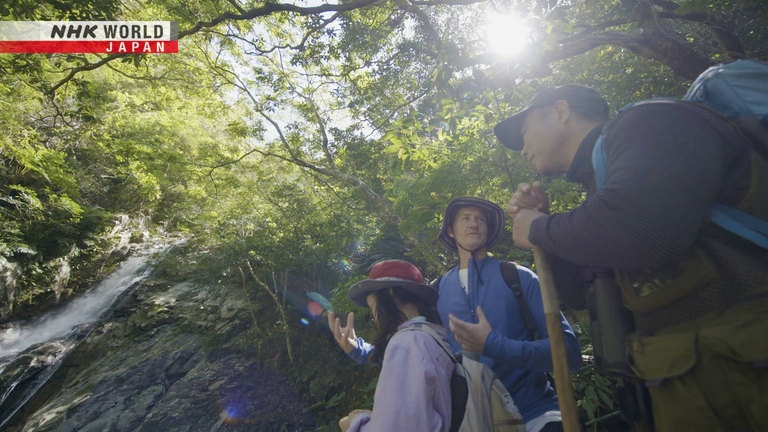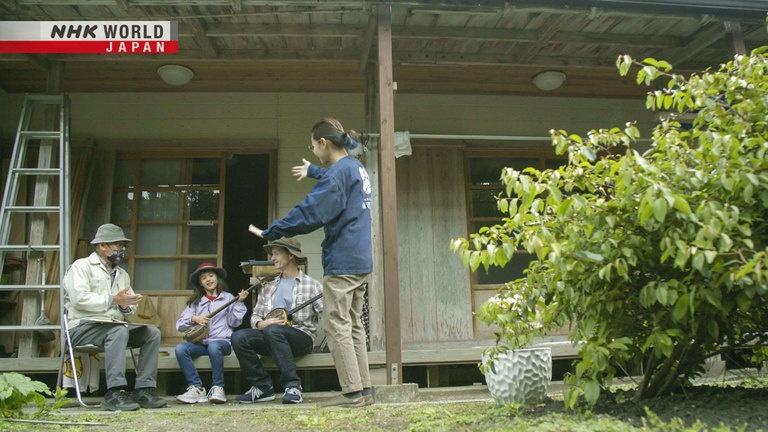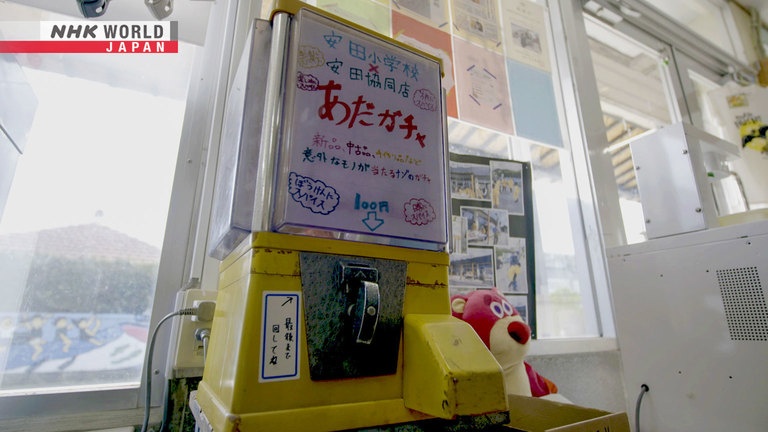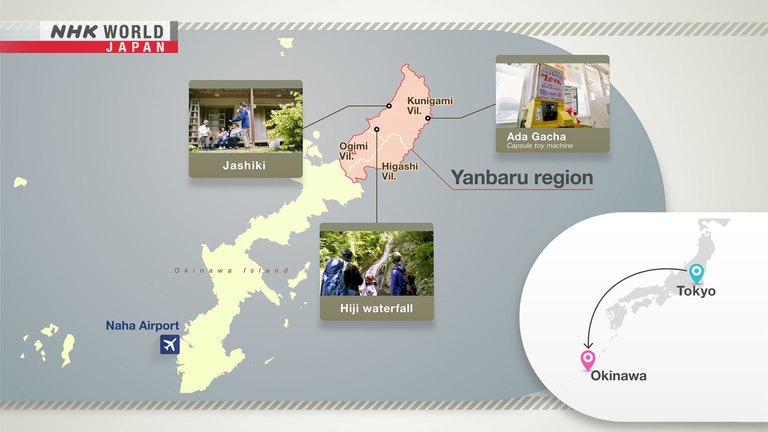Rambling Around Secluded Yanbaru
Yanbaru is an area in the north of Okinawa Prefecture's main island. Covered by subtropical evergreen forest, it is home to a diverse range of native species and a unique ecosystem. In 2021, it was listed as a UNESCO Natural World Heritage site. In this journey, a father-daughter pair visits villages scattered across Yanbaru and meet locals who share a strong bond with their land.
Hiji Waterfall Hike

Book a guide to discover the fall's beauty and the rare ecosystems, as well as how people have co-existed with nature here.
Jashiki - Village Stay -

Interact with locals and experience first-hand how they live close to the land.
Ada Gacha (Project by Local Elementary School)

Put a coin in a Gacha machine and open your capsule to discover handmade gifts and messages prepared by local school kids. Proceeds go back to the community.
Access

From Tokyo, it is about two and a half hours by plane to Naha Airport. From there, it is a two-hour drive to Ogimi Village, the entrance to Yanbaru.
Transcript
"Journeys in Japan"
I really wanted to show you this.
(Dawn, Yanbaru forest)
It's as if they're saying, "Good morning."
I can hear them chirping.
Yanbaru, a hidden gem on Okinawa's main island.
Its lush forest, nestled in the mountains,
has nurtured a precious ecosystem unlike any other in the world.
On "Journeys in Japan,"
Okinawa-based Kenneth, and his daughter Emma
explore the secluded area.
They visit villages,
meeting people who coexist with the subtropical woodlands...
and plunging their oars into the water.
Rambling Around Secluded Yanbaru
Some 2,000 kilometers southwest of Tokyo,
Yanbaru spans three villages in northern Okinawa.
About 80 percent of the area,
which receives copious rainfall,
is carpeted by primeval forest.
I can hear a river.
Water is abundant here. It collects in gullies, turning into little streams.
Come on!
- Daddy, Daddy!
- Oh, nice.
- This is wobbly.
- Yeah, you okay?
- Yeah!
- You're not scared?
Wow, look at this, Emma.
Look. This is "Itajii" chinkapin.
It's soft and thick.
Itajii makes up about 70 percent of Yanbaru's trees.
It has flowers now, but do you know what comes next?
Fruit.
Good. It's even tasty to humans, so...
It's tasty for animals.
Right. Yanbaru's long-haired rat and the spiny rat feed on it.
We call the Itajii "the mother tree."
- A mother tree.
- Yes.
Let's keep it up!
Daddy, look.
It's like a family!
- What, the trees?
- Yeah.
Oh, yeah. They do look like a family.
They're all growing from the same roots. Yeah?
- Why?
- Well, that's a good question.
And here's the answer.
What's this?
Charcoal making...
A large charcoal kiln's ruin.
Locals once earned a living by selling the charcoal and firewood they prepared
to people in nearby towns.
They brought the trees they cut down here and turned them into charcoal.
The roots were still alive, so the trees grew back.
That's what's happened with the ones you saw.
I see.
They bear a lot of fruit near the top.
They sustain Yanbaru's creatures.
That happened by chance, not by design, right?
Yes. The forests of Yanbaru are in excellent condition.
Chinkapin acorns.
You found some?
A whole bunch.
Good job, Emma.
So, this is the food
that's dropping from the trees.
So this is what the animals are eating.
Good find, Emma. Wow. Don't eat the animals' food.
- We've made it!
- Wow, look at that, Emma!
That's amazing.
Beautiful.
It's the tallest waterfall on the island.
It looks beautiful, eh? What do you think of this...
Do you think this is good for the animals?
They like it.
We've walked a lot. Are you tired?
I'm pooped.
Wow. We had a great time walking through this beautiful forest.
It's been an amazing time.
We'll meet again.
Yes.
Emma-chan, the mountain on one side,
and then the ocean on the other side we've got.
Thank you.
Okay, let's go this way.
(Jashiki, a settlement on the sea)
Yeah, it looks like this is the place. Yeah.
Yanbaru Hotel.
Hello.
Nakamoto Itsumi, who was born and raised in Yanbaru,
promotes local tourism
including converting vacant homes into vacation rentals.
Jashiki is a quiet village,
home to 28 residents.
That's a dragon fruit tree. Have you ever eaten its fruit?
Yes.
Do you like it?
- Yes!
- Nice.
"Fukugi," a tree with dense foliage,
is planted around residences to protect them against wind and seawater.
From here on, the road is too narrow for cars. We can only walk.
We turn here.
This is something. It's a maze.
Because you can't see the houses.
This is great for privacy.
That's the sound of an instrument called the "sanshin."
It's a lovely sound.
- Let's go and say hello.
- Sure.
Hello.
Thank you for clearing the path.
The fukugi was getting out of hand.
- May we go inside?
- Sure.
There's a cat.
- It's cute.
- Is it?
These are our guests tonight, Mr. Slater and his daughter, Emma.
- Nice to meet you.
- Nice to meet you, too!
I'll play a piece of sanshin.
Oh, we'd love to hear you play. Is that okay?
Can we listen to you play?
- Okay, I'll show you.
- Oh, great!
- Thank you.
- Awesome.
There's a pretty flower.
Just one...
We've come to a road. What are they doing?
Are they your staff?
The people wearing the same jacket are. The rest are from the village.
Can we help trim the fukugi?
Really?
The branches are hard.
They are. You have your work cut out for you.
You've trimmed a lot.
It feels good to be helping this community do this,
but it also feels good just to do the work.
It's satisfying.
Let's clip this one, too.
It's getting into shape.
What will you do with all these branches, Nakahara-san?
We'll collect them and use them for dyeing.
Dyeing?
Thank you so much.
It's all clean now. You did a good job, Emma.
This is your place for the night.
This is great. It's beautiful.
It's charming.
Look at these curtains, Emma-chan.
This is like a "noren" or something. It's beautiful.
They used fukugi to dye the curtains.
- So you got this color from the fukugi?
- Yes.
It goes from light to dark.
Yes. It has a nice gradation.
Nakahara shows up with a gift for Emma.
- We have to first hear how to do it.
- You're right.
Daddy, you do this. I'll do this.
I can do that.
You can do it.
- It warmed up.
- It was so chilly this morning.
- Oh, there you go.
- Awesome.
Playing with fire is not always bad.
I agree.
How many times do you dip it?
Well, probably around three times today.
It has turned yellow.
It's beautiful. The color of fresh green.
Right.
Amazing to see that
the natural surroundings can be used to produce something like this.
And you can tell the seasons.
You feel the season by the passing of these
processes the generations have passed down. It's really cool.
There is a place deep in the mountains
once accessible only by boat.
Ogimi Village sits on the scenic Shioya Bay
which cuts deep inland.
I think it's here, Emma.
Hello.
Hentona Teppei, whose family has lived here for 200 years,
is a boat carpenter.
Using neither nails nor screws,
he crafts the traditional Okinawan wooden vessel called "sabani."
- Are you ready?
- Yes.
Let's go.
Off we go.
Let's go!
It feels great.
- Let's use the wind.
- Use the wind?
Hey, Emma-chan, can you see how fast we're going? Look, look.
We're going fast now. We're not paddling
but we're moving. Wow, that feels great.
It's great when you don't hear the engine.
From the water, you can really see the steep
hills around here.
They're really rugged terrain.
I can't imagine having to traverse this with
large packs of gear and stuff.
Before the bridge was built, the ferry service ended before sunset.
When people missed the last boat,
they'd call out to the other side, "Please come get us."
And the person who heard them would borrow a nearby boat and pick them up.
We're catching a strong wind.
This is really fast!
Would you like to try this, Emma?
Yes.
Control the sail?
Come over here. Careful not to trip.
- We've got wind.
- Can you feel it?
- I can feel the pull.
- You feel it...
That's great.
I have a one-year-old son.
When he turns 20, I hope to tell him that
the sea is far more beautiful now than when he was a baby.
It would be wonderful if I could say that.
Cheers!
Thanks for letting us be a part of your community.
Thank you.
It's been more like an experience than a tour.
To be a part of your world, for even just one day,
has been a tremendous experience.
Makes me want to move here.
(Yanbaru Byobu, Ink brush painting)
(Artist Kikuta Ichiro depicts the cycle of life in Yanbaru's nature.)
(Using hand-made washi paper, he embraces the "tarashikomi" technique...)
(that drops ink over an initial layer before it dries for a pooling effect.)
(This technique resonates with Kikuta's idea that living things connect like flowing water.)
You can see this mangrove, too, Emma-chan. Look over there.
The father and daughter duo are now in the village of Ada.
What's that, Emma?
It's a Yanbaru "kuina."
- Kuina. Yeah.
- Where is a real kuina?
Real kuina? Maybe around here somewhere.
Ada kyodoten?
Kyodo... ten?
Every town needs a store like this.
Yes!
Coffee.
- This?
- Yeah.
What's Ada Gacha?
Ada Gacha?
Excuse me, tell us about Ada Gacha.
Ada Gacha is a project launched by students at the Ada Elementary School...
to reinvigorate the community, the school and my store.
That's fascinating.
- You want to give it a try?
- Yes!
Well, okay. Let's try it out.
I need 100 yen.
Okay.
Gacha gacha...
This way. There you go.
You've got it.
It's got a whole bunch of stuff in there.
How cute! It's probably hand-made.
Hello.
A teacher and students are running the Ada Gacha project.
After school, they get together to turn unused items
into tiny treasures.
- There are only two left.
- Yeah, only two.
What was a bit of fun for the town
turned into a phenomenon with over 200 items
selling out every month.
Ada Gacha was launched about nine months ago
as a community workshop project.
The children tally up sales and use profits to help the community.
They donate a portion of proceeds to an NPO that operates medical helicopters,
which are indispensable to a remote community like theirs.
What do you think about this project?
I never thought we could achieve so much in afterschool hours.
It's a good way of spending our spare time.
Choose a pen and write whatever message you want.
By writing special messages on buoys collected during beach cleanups,
the kids turn them into lucky charms.
We love Ada!
That's great. Good job, Emma.
Oh, wow. That's really cool.
This one... is?
Kuina. Oh, yes.
You've all done a brilliant job.
Awesome.
If you make Gacha prizes from home, I can put them in the machine.
We can stay connected that way.
That's a brilliant idea.
To cap off their journey, they visit the northernmost village of Oku.
(Oku)
The children have picked these leaves.
That's a lot.
A lot.
Wow, it's a beautiful color.
I think this one.
Well, maybe not so good.
- How about this?
- It's fine.
Yanbaru has the perfect climate and soil for growing tea.
Okay.
This is the first tea harvest of the season.
- It's valuable, isn't it?
- That's right.
Sakihara Hidetoshi, who heads the tea farmer cooperative,
invites local children to his fields
so they can try their hand at tea farming.
Our ancestors worked hard to develop this tea.
Oku became famous thanks to their efforts.
Impressive.
Locals affectionately call their tea "Okumidori,"
literally, "the green of Oku."
This is probably one of the best smells
you can smell in the world. It's just amazing.
I love drinking "ocha" in Japan. The tea here is amazing.
But the smell of this freshly roasted tea is unbelievably good.
Rub three times...
Don't knead too hard.
We also use the tea leaves in cooking. It's "local production for local consumption."
We enjoy such dishes in our school lunches.
That's great.
Okay, okay.
Can you tell by the smell?
- It smells like tea.
- Right. It's a great aroma.
What a treat to drink the freshly picked tea.
Thank you for teaching us about "Okumidori."
We'll now enjoy the "Okumidori" you've produced.
Thank you.
It has a fine aroma.
Yes. It tastes great, too. Wonderful.
- This is good, isn't it?
-Yes.
You've put it on your muffin?
Yep. I'm changing the maple flavor to our tea.
- Do you do this often?
- Yes.
It's really good.
I might give it a try.
You might start selling tea muffins someday.
That's fantastic. I like the idea.
Coming to the Yanbaru area, it's not so easy,
or at least, I didn't know at first, how it became to be this beautiful place
in spite of the fact that so many people have lived here for many years.
I think the answer to that, that we have seen through our travels,
is how people have strong connections between the land
and the people here, the older generations,
how they've preserved the land in a way that
they can pass it on further generations,
and how the younger generation has
taken on the customs and culture
of the older generation as well.
So I think this is really a key to understanding
how this beautiful place has been preserved,
and will continue to be preserved for future generations as well.
To reach Yanbaru from Tokyo,
it takes two and a half hours by plane to Naha.
From there, it's about a two-hour drive
to Ogimi Village,
the entrance to the forest area.